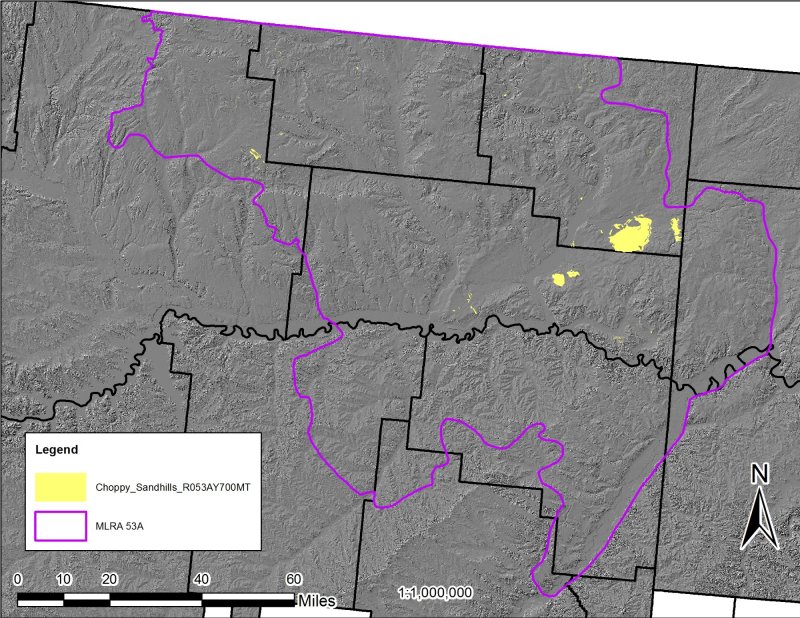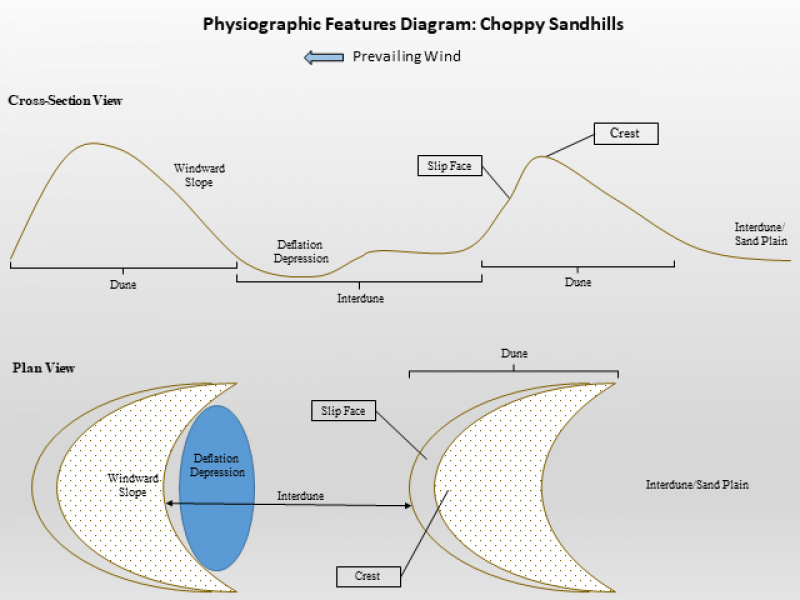
Natural Resources
Conservation Service
Ecological site FX053A99X700
Choppy Sandhills (CS)
Last updated: 4/21/2025
Accessed: 04/24/2025
General information
Provisional. A provisional ecological site description has undergone quality control and quality assurance review. It contains a working state and transition model and enough information to identify the ecological site.
MLRA notes
Major Land Resource Area (MLRA): 053A–Northern Dark Brown Glaciated Plains
The Northern Dark Brown Glaciated Plains, MLRA 53A, is a large, agriculturally and ecologically significant area. It consists of approximately 6.1 million acres and stretches 140 miles from east to west and 120 miles from north to south, encompassing portions of 8 counties in northeastern Montana and northwestern North Dakota. This region represents part of the southern edge of the Laurentide Ice Sheet during maximum glaciation. It is one of the driest and westernmost areas within the vast network of glacially derived prairie pothole landforms of the Northern Great Plains and falls roughly between the Missouri Coteau to the east and the Brown Glaciated Plains to the west. Elevation ranges from 1,800 feet (550 meters) to 3,300 feet (1,005 meters).
Soils are primarily Mollisols, but Inceptisols and Entisols are also common. Till from continental glaciation is the predominant parent material, but alluvium and bedrock are also common. Till deposits are typically less than 50 feet thick (Soller, 2001). Underlying the till is sedimentary bedrock largely consisting of Cretaceous shale, sandstone, and mudstone (Vuke et al., 2007). The bedrock is commonly exposed on hillslopes, particularly along drainageways. Significant alluvial deposits occur in glacial outwash channels and along major drainages, including portions of the Missouri, Poplar, and Big Muddy Rivers. Large eolian deposits of sand occur in the vicinity of the ancestral Missouri River channel east of Medicine Lake (Fullerton et al., 2004). The northwestern portion of the MLRA contains a large unglaciated area containing paleoterraces and large deposits of sand and gravel known as the Flaxville gravel.
Much of this MLRA was glaciated towards the end of the Wisconsin age, and the maximum glacial extent occurred approximately 20,000 years ago (Fullerton and Colton, 1986; Fullerton et al., 2004). Subsequent erosion from major stream and river systems has created numerous drainageways throughout much of the MLRA. The result is a geologically young landscape that is predominantly a dissected till plain interspersed with alluvial deposits and dominated by soils in the Mollisol and Inceptisol orders. Much of this area is typic ustic, making these soils very productive and generally well suited to production agriculture.
Dryland farming is the predominant land use, and approximately 50 percent of the land area is used for cultivated crops. Winter, spring, and durum varieties of wheat are the major crops, with over 48 million bushels produced annually (USDA-NASS, 2017). Areas of rangeland typically are on steep hillslopes along drainages. The rangeland is mostly native mixed-grass prairie similar to the Stipa-Agropyron, Stipa-Bouteloua-Agropyron, and Stipa-Bouteloua faciations (Coupland, 1950, 1961). Cool-season grasses dominate and include rhizomatous wheatgrasses, needle and thread, western porcupine grass, and green needlegrass. Woody species are generally rare; however, many of the steeper drainages support stands of trees and shrubs such as green ash and chokecherry. Seasonally ponded, prairie pothole wetlands may occur throughout the MLRA, but the greatest concentrations are in the east and northeast where receding glaciers stagnated and formed disintegration moraines with hummocky topography and numerous areas of poorly drained soils.
Classification relationships
NRCS Soil Geography Hierarchy
• Land Resource Region: Northern Great Plains
• Major Land Resource Area (MLRA): 053A Northern Dark Brown Glaciated Plains
National Hierarchical Framework of Ecological Units (Cleland et al., 1997; McNab et al., 2007)
• Domain: Dry
• Division: Temperate Steppe
• Province: Great Plains-Palouse Dry Steppe Province 331
• Section: Glaciated Northern Grasslands Section 331L
• Subsection: Glaciated Northern Grasslands Subsection 331La
• Landtype association/Landtype phase: N/A
National Vegetation Classification Standard (Federal Geographic Data Committee, 2008)
• Class: Mesomorphic Shrub and Herb Vegetation Class (2)
o Subclass: Temperate and Boreal Grassland and Shrubland Subclass (2.B)
Formation: Temperate Grassland and Shrubland Formation (2.B.2)
• Division: Central North American Grassland and Shrubland Division (2.B.2.Nb)
o Macrogroup: Andropogon hallii - Calamovilfa longifolia - Artemisia filifolia Great Plains Sand Grassland & Shrubland Macrogroup
Group: Andropogon hallii - Calamovilfa longifolia - Hesperostipa comata Sand Grassland Group
• Alliance: Andropogon hallii Sand Prairie Alliance
• Alliance: Calamovilfa longifolia Sand Prairie Alliance
o Macrogroup: Hesperostipa comata - Pascopyrum smithii - Festuca hallii Grassland Macrogroup (2.B.2.Nb.2)
Group: Pascopyrum smithii - Hesperostipa comata - Schizachyrium scoparium Mixedgrass Prairie Group (2.B.2.Nb.2.c)
• Alliance: Prunus virginiana - Symphoricarpos occidentalis - Amelanchier alnifolia Great Plains Shrubland Alliance
EPA Ecoregions
• Level 1: Great Plains (9)
• Level 2: West-Central Semi-Arid Prairies (9.3)
• Level 3: Northwestern Glaciated Plains (42)
• Level 4: Glaciated Dark Brown Prairie (42i)
Glaciated Northern Grasslands (42j)
Ecological site concept
This provisional ecological site is limited to areas of wind-deposited sediments in MLRA 53A. Choppy Sandhills is an ecological site of limited extent occurring in areas of wind-transported sands, known as eolian sands. This site is characterized by an undulating, dynamic landscape of dunes or dune fields. Soils typically contain more than 70 percent sand and have little or no development. Characteristic vegetation is Indian ricegrass (Achnatherum hymenoides), lemon scurfpea (Psoralidium lanceolatum), various bunchgrasses, chokecherry (Prunus virginiana), and western snowberry (Symphoricarpos occidentalis).
Associated sites
| FX053A99X110 |
Sandy (Sy) This site occurs on alluvial deposits adjacent to the Choppy Sandhills ecological site. It is generally on outwash fans, alluvial fans, or terraces whereas the Choppy Sandhills ecological site is on eolian sands. |
|---|
Similar sites
| FX053A99X110 |
Sandy (Sy) This site differs from the Choppy Sandhills ecological site in that it is not derived from eolian sands and its soils typically contains less than 70 percent sand. |
|---|
Table 1. Dominant plant species
| Tree |
Not specified |
|---|---|
| Shrub |
Not specified |
| Herbaceous |
(1) Calamovilfa longifolia |
Legacy ID
R053AY700MT
Click on box and path labels to scroll to the respective text.
| T1A | - | Introduction of non-native grass species, such crested wheatgrass. |
|---|---|---|
| T2A | - | Improper grazing management, warmer and drier climatic conditions. |
| T2B | - | Displacement of native species by non-native invasive species (Crested Wheatgrass, noxious weeds, etc.) |
| R3A | - | Critical area seeding, proper grazing management (management intensive and costly); or cooler, moister climatic conditions |
| T3B | - | Recolonization of site by non-native species (Crested Wheatgrass, noxious weeds, etc.) |
State 1 submodel, plant communities
| 1.1A | - | Recolonization by perennial plants and soil entrapment |
|---|---|---|
| 1.2A | - | Localized disturbance, such as heavy grazing, or short-term drought |
| 1.2B | - | Establishment of stable woody vegetation and site stabilization of dune faces |
| 1.2C | - | Establishment of stable woody vegetation and site stabilization of interdunes |
| 1.3A | - | Localized disturbance, short term drought |
| 1.4A | - | Localized disturbance, short term drought |
State 2 submodel, plant communities
| 2.1A | - | Recolonization by perennial plants and soil entrapment |
|---|---|---|
| 2.2A | - | Localized disturbance (i.e. fire, improper grazing, mechanical disturbance), drought |
| 2.2B | - | Establishment of stable woody vegetation and site stabilization of dune faces |
| 2.2C | - | Establishment of stable woody vegetation and site stabilization of interdunes |
| 2.3A | - | Localized disturbance (i.e. fire, improper grazing, mechanical disturbance), drought |
| 2.4A | - | Localized disturbance (i.e. fire, improper grazing, mechanical disturbance), drought |

